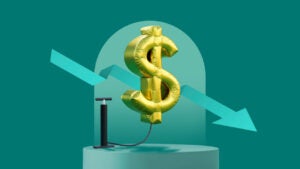How to protect your money from rate decreases with a CD

With interest rates on the decline, a smart CD strategy can help you earn an extra bit of yield on your money.
Many savings deposit accounts and CD rates have decreased after the Federal Reserve slashed rates twice to a range of 0-0.25 percent in March due to the coronavirus pandemic. According to Bankrate data, the average one-year CD yield has fallen to less than 0.3 percent, while the average savings account APY is a mere 0.09 percent.
No matter where rates are, people are still leaving money on the table if they aren’t earning any interest. Nearly 1 in 4 Americans weren’t earning any interest on their short-term savings, according to a Bankrate survey in May 2019.
How a CD can help you lock in returns
A CD can help you secure a higher, fixed yield for an extended period of time. Even though CD rates have also declined in general, you can still find one-year CDs offering APYs around 0.9 percent.
CDs offer a fixed APY, whereas savings and money market accounts offer variable APYs. Plus, the Federal Deposit Insurance Corp. (FDIC) backs your CD if it’s at an FDIC-insured bank and within insurance limits and guidelines.
For those on the fence about purchasing a CD, it might be a good time to consider making the move. Adam Stockton, director of consumer pricing at Novantas, says to consider these two thing before getting a CD.
- Be sure you’re confident you can lock your money away for the CD’s term length.
- Understand how the CD fits into your overall financial goals.
Research CD penalties to be aware of the worst-case scenario, if you were to break the CD early. A four-year or five-year CD may have a penalty of as much as 540 days of interest.
A no-penalty CD can be a happy medium if you’re not sure when you’ll need these funds. As the name suggests, a no-penalty CD offers a fixed APY without the risk of a penalty. However, the APY is usually lower than a traditional CD. Often, a no-penalty CD will not allow for withdrawals to be made during the first few days (while the ones that do may charge a penalty).
Boost earnings with a CD ladder
A CD ladder is a strategy where you might buy multiple CDs and stagger their maturity dates. This way you’re both diversifying your future rates and liquidity.
“By saving in a variety of maturities, one gains some liquidity or flexibility when new opportunities for that money, possibly higher rates, come until view,” says Mark Hamrick, Bankrate’s senior economic analyst.
For example, let’s say a five-year CD doesn’t appear to be the right option for you because you’ll likely need some of those funds before the five years are up and want to avoid a penalty for early withdrawal. But if you had a ladder with a one-year CD, a three-year CD and a five-year CD, one of your CDs would be much closer to maturity if you needed to access some of the money.
You’ll be glad you have some longer-term CDs in your ladder, if CD and savings rates continue to decrease. Even more than a month after the Fed’s two emergency rate cuts, CD rates and savings rates continue to decrease. However, it’s not too late to get a competitive fixed APY on a CD, as variable savings rates may fall further.
Meanwhile, shorter-term CDs can be put into higher-yield CDs upon maturity if rates increase. You can use Bankrate’s CD Ladder Calculator to help build a ladder.
Learn more:
- Yield without worries: Check out no-penalty CDs
- Top 18 strategies for CD savers
- How to keep your money from losing purchasing power
Why we ask for feedback Your feedback helps us improve our content and services. It takes less than a minute to complete.
Your responses are anonymous and will only be used for improving our website.






